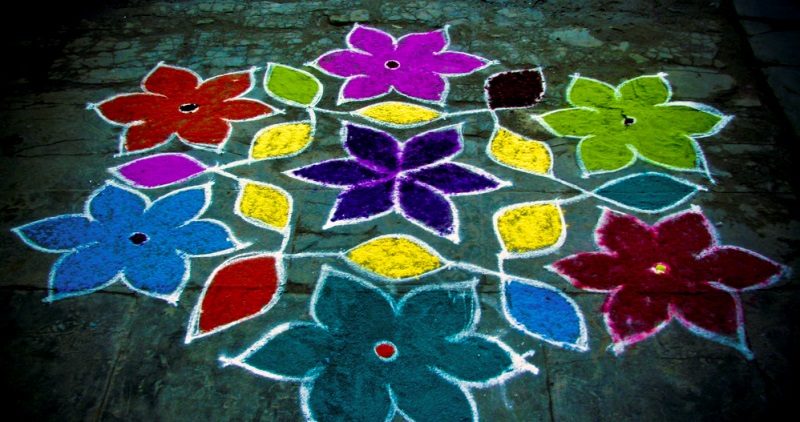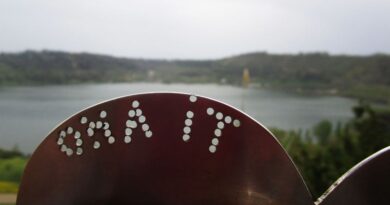Multiple journeys from white void – Un amore della durata del fulmine
di Gouthama Siddarthan
La settimana scorsa lo scrittore e critico di fantascienza Massimo Soumarè mi ha scritto, dicendo che aveva trovato una parte del mio articolo, sulla comunità dei lavandai, pubblicato la scorsa settimana,una buona lettura, e voleva anche saperne di più sulla loro vita. Sentendomi entusiasta della risposta e dell’opportunità di presentare una scena così sublime come quella globale, mi sedetti per scrivere, pronto a partecipare, ma le celebrazioni di San Valentino mi distrassero, in generale, e in particolare, lo stile peculiare della “La Festa degli Innamorati” italiana mi ha reso ancora più curioso. La metafora descritta in Ho voglia di te dell’autore italiano Federico Moccia, che stava dietro l’atto di bloccare due lucchetti e lanciare le chiavi nel fiume, mi ha incantato con un fascino irresistibile. Le immagini pittoresche dei lucchetti che pendono dalle colonne, dai ponti e sulle rive del fiume mi hanno colpito in modo epico.
La velocità lampo con cui quelle visioni mi hanno colpito mi ha catapultato in una scena classica della mia infanzia, che era parte integrante della mia coscienza. La tonalità giallastra dei colocynthis che pendevano come trecce di capelli arruffati nella foresta riportava il sole nella stagione invernale. Le parole del grande poeta italiano Cesare Pavese, “Non ricordiamo i giorni, ricordiamo i momenti”, vibravano in me, mi costringevano a condividere con me i momenti storici in cui i colocynthis, assumendo proporzioni epiche, diventavano trama e ordito della mia adolescenza. Oh, mio Dio, benedicimi con il potere di agitare le onde sul fiume italiano Tevere! Qui, nel nostro Tamil Nadu, le celebrazioni per San Valentino non sono grandi; si accontentano di innescare solo piccole onde in aree metropolitane come Chennai.
Ma questa celebrazione nel nome di San Valentino si celebra nel mio Paese nel nome di ‘kaanum Pongal’ (nel giorno in cui i parenti, gli amici e gli amanti si incontrano), celebrato il quarto giorno del famoso festival Pongal dei Tamil. Questa festa indigena è celebrata nei villaggi in pompa magna. In questo giorno, le persone visitano le pietre tombali dei loro antenati e le adorano, e poi visitano i loro anziani e parenti e condividono con loro cibo e amore. La più importante di tutte è la scena rituale dei nostri giovani e ragazze rurali che lanciano i colocynthis nel gorgogliante fiume Kaveri. I frutti acerbi che turbinano nelle onde scroscianti del fiume avrebbero inebriano le persone in piedi sulle rive, che scoppiano in espressioni di estasi.
Questi frutti acerbi chiamati colocynthis (“kumittikaai” in tamil), coltivati nei campi del villaggio, hanno proprietà medicinali che hanno il potere di alleviare il dolore delle gambe e delle mani e di energizzare il corpo. Ma al di là delle caratteristiche medicinali, c’è una storia d’amore molto commovente dietro a questi frutti acerbi che conta. In tutto il Tamil Nadu, questa celebrazione del quarto giorno del festival Pongal avviene in modi diversi in diverse regioni, ma nella nostra regione è celebrata come una festa d’amore rurale molto famosa, avendo come caratteristica principale l’atto rituale di lanciare i colocynthis nel fiume.
Da bambino, l’evento mi travolgeva. Insieme alla gente, ero pesantemente inebriato dalla scena scintillante dei frutti acerbi che luccicavano contro i raggi giallastri del sole, fluttuando tra le onde. Mentre chiedevo alla bisnonna del nostro villaggio informazioni sull’evento che si era trasformato in un mito sorprendente e sconcertante come parte dell’universo della mia infanzia, lei tornò ai giorni antidiluviani della storia popolare con molti labirinti d’amore. Mentre raccontava la storia, il suo viso permeato dei raggi dorati che brillavano come il polline giallastro dei fiori.
Come parte di questo festival celebrato con gran pompa come ‘kaanum Pongal’, si svolgevano vari giochi e sport. Le persone prendevano parte con gusto alle esibizioni popolari chiamate “kolattam”, “kummiaattam” e “oyilattam”. Ma nel nostro villaggio, di tutti i giochi, quello che si giocava con la palla e conosciuto nel nostro linguaggio locale come “Idu panthu” (Battere il gioco della palla) era abbastanza famoso, e per prendevi parte arrivavano orde di persone dai villaggi vicini, donne comprese.
Il colocynthis veniva usato come una palla nel gioco. Le donne lanciavano il colocynthis come una palla su uomini che correvano, zigzagando per sfuggire all’attacco. C’erano occasioni in cui gli uomini, a petto nudo, cercavano di scappare ma venivano catturati mentre il frutto acerbo, duro e solido, simile a una palla, colpiva loro sul petto o sulla schiena, su cui colava il succo carnoso del frutto acerbo. Gli spettatori applaudivano, deridendo gli uomini che correvano, schizzando il succo carnoso del frutto acerbo per tutto il corpo. L’evento era contraddistinto da un sacco di baccano.
I colocynthis erano disponibili in abbondanza nei campi di pascolo, cresciuti come trecce arruffate e le giovani donne, alla vigilia del festival annuale di Pongal, li raccoglievano nel loro cesto. In questo gioco, la donna più famosa era Thavasiamma che si era guadagnata la fama di essere quasi una massacratrice di uomini con i colocynthis; e quelli, attaccati in tal modo, si scatenavano correndo, il succo carnoso del frutto acerbo che scorreva sulle loro membra.
Un giorno durante la celebrazione, alcune informazioni segrete emersero su di lei. La gente in giro si chiedeva da tempo perché Thavasiamma, che assaliva tutti gli uomini con la “palla” e non ne risparmiava nessuno, non avesse mai gettato la colocynthis su un uomo di nome Vaiyapuri. Voleva evitarlo deliberatamente o era un uomo talmente valoroso da non riuscire a colpirlo? Prendendo molto sul serio questo problema, le ragazze le chiesero che gli lanciasse la palla, dicendo che se non l’avesse fatto, avrebbe significato un grande disonore per il gioco. La mia bisnonna mi raccontò delle voci secondo le quali erano davvero amanti segreti. Mi raccontò l’evento facendo un disegno.
Un giorno Vaiyapuri andò con i suoi amici in un fiume, mentre faceva il bagno, il suo indumento intimo (chiamato “kovanam” in tamil, una lunga striscia di tessuto che funge da slip maschile) scivolò e venne portato via nelle acque. Dopo una vana ricerca e a corto di idee, si tuffò nelle profondità, affrontando le acque piene di fango e alghe. Sentendosi imbarazzato della sua nudità, emerse. Allorché gli amici si preparavano ad andare via, lo chiamarono, chiedendogli di venire a riva. Nascondendo dentro di sé la sua tensione, disse che sarebbe uscito dopo aver finito di lavarsi. Quelli avevano sospettato qualcosa di sbagliato perché Vaiyapuri era solito andare in giro con i suoi amici ed era inaudito che andasse da solo. Il modo in cui era in piedi al centro del fiume, il suo viso con un’espressione confusa e nervosa, aumentarono i loro sospetti. Domande insistenti rivelarono che aveva perso la biancheria intima, e perciò se ne stava fermo in mezzo al fiume.
Fischiando in tono di derisione, gli amici iniziarono a sentirsi divertiti e con un tono di voce beffardo, dissero, “Vieni fuori.” Uno sfortunato Vaiyapuri chiese di prendere il suo dhoti sulla riva e di lanciarglielo. In piedi nell’acqua fino alla vita, non osava uscire, anche se c’erano solo uomini in giro. Il tempo stava scadendo. Anche gli amici si rifiutarono di spostarsi di un millimetro dal posto. I suoni di derisione e divertimento crebbero e il gruppetto persone in pochi minuti crebbe fino a diventare una grande folla.
“Ehi, i pesce del fiume mi morsicherebbero. Non ci sono medicine per la ferita. Vieni a riva”, gridarono. Ma lui era irremovibile nel rifiutarsi di uscire. Un uomo anziano commentò: “Sei una donna? Perché ti vergogni di uscire nudo?” La nudità ha parametri diversi per gli uomini e per le donne? “Quali sono le idee di base sulla nudità?” – Vaiyapuri si domandava.
La sua testa girava con i ricordi di un episodio del dramma popolare Alli Arasaanimaalai in cui al protagonista Arjun veniva strappato il perizoma da un piccione con il becco tagliente. Per un momento, Arjun rimaneva fermo, completamente disonorato e in totale agonia. E poi cantava una canzone di dolore acuto. Ora la canzone si stava riversando nella mente di Vaiyapuri. “OK. Per quanto tempo puoi resistere in piedi nell’acqua? In un modo o nell’altro, devi venire a riva”, dissero gli amici, e si andarono a sedere sotto i rami di un albero. Il sole di mezzogiorno batteva sul suo cranio.
Il tempo che trascorreva tra il suo senso di vergogna e il dolore di stare in piedi per ore nelle acque sembrava rallentare fino a fermarsi. All’improvviso, prima che gli altri capissero cosa stava succedendo, Vaiyaurai stava uscendo fiducioso dall’acqua, un sari arrotolato intorno alla vita.
Come è successo questo miracolo? Si chiesero i suoi amici. Quello sì che era un segreto profondo! Ma, come risultò, fu Thavasiamma, che, sentendo parlare dell’episodio del fiume in quel momento, si tuffò nel fiume a un chilometro di distanza e nuotò di nascosto sott’acqua e lo raggiunse di soppiatto, dandogli un sari e scomparve inosservata, tornando indietro a nuoto. (Alcuni anni fa, mentre leggevo L’avventura di una bagnante di Italo Calvino, mi sentii scioccato e gioioso allo stesso tempo. Ho riflettuto a lungo sull’intertestualità che si sta formando tra l’avventura della signora Isotta nuda in mezzo al mare e l’avventura di Thavasiamma).
Ora, torniamo al gioco della palla.
Quell’anno, il gioco stava per iniziare, la gente del villaggio si radunò in gran numero e attese col fiato sospeso. Le donne erano pronte con i colocynthis; ma Thavasiamma doveva ancora presentarsi. Le voci raccontavano che alcune persone provenienti da un luogo lontano avevano visitato la sua casa per chiedere la sua mano a nome di un uomo desideroso di sposarla. Ma lei aveva respinto quell’offerta perché aveva indirettamente proposto a Vaiyapuri lanciandogli un fiore noto come Aavarampoo (fiore di cassia). Ma lui non aveva risposto alla sua offerta, superandola in silenzio. (Qui vale la pena di spiegare un mito popolare sul fiore che la gioventù rurale ammirava molto per rendere la storia ancora più interessante: in quei giorni, questo fiore serviva come simbolo romantico: una donna lo gettava verso un uomo che amava e viceversa. Se una donna non è disposta ad accettare la proposta di un uomo, non porta il fiore tra i capelli).
Alla fine la partita iniziò e proprio in quel momento, Thavasiamma si presentò. Sebbene inizialmente giocasse senza troppo fervore, a un certo punto cominciò a prendere impeto e a giocare in modo piuttosto vivace. Gli uomini iniziarono a disperdersi in tutte le direzioni. Accadde esattamente in quel momento. Vedendo Vaiyapuri all’estremità meridionale del terreno, lei si avventò su di lui con la colocynthis e lo colpì precisamente sul petto. Mentre la gente intorno guardava meravigliata, il petto di Vaiyapuri iniziò a gocciolare con il succo carnoso del frutto acerbo. Guardandosi attorno in modo vacuo, si fermò bruscamente e cadde dritto nel fiume. La gente era totalmente esterrefatta dall’incidente, che si era svolto con la velocità del fulmine. In seguito, Vaiyapuri non fu mai più visto; né se ne sentì parlare. Da allora i giovani lanciano sempre colocynthis nel fiume Kaveri nella nostra regione il giorno di kaanum pongal. Riguardo l’intertestualità tra le innumerevoli chiavi nascoste nelle profondità del fiume Tevere e le innumerevoli coloynthis che fluttuano tra le onde del fiume Kaveri, solo Julia Kristeva può dirci qualcosa.
Traduzione di Davide Mana
Testo originale
Love as long as lightning
by Gouthama Siddarthan
Last week sci-fi writer and critic Massimo Soumare’ wrote to me, saying that he had found the portion in my article, published last week, about the Washerman community a good read and also he wanted to know more about their life. Feeling enthused over the response and opportunity to introduce a scene as sublime as a global one, I settled down to write, ready to key in, the Valentine’s celebrations distracted me, in general, and in particular, the peculiar style of the Italian ‘La FestadegliInnmorati’ made me all the more curious. The metaphor described in Italian author Federico Moccia’s ‘Ho voglio di te,’ which was behind the act of locking two padlocks and throwing the keys into the river cast an irresistible charm on me. The picturesque imagery of the padlocks hanging from the posts, bridges and on the river banks struck me quite epic-like.
The lightning speed with which those visions hit me catapulted me back to a classic-like scene in my childhood, which was part and parcel of my consciousness.
The yellowish hue of colocynths hanging like matted tresses of hair in the forest brought back the sunshine in the winter season.
The words of great Italian poet CesarePavese, “We do not remember days, we remember moments,” vibrated in me, compelled me to share with me the historic moments when the colocynths assuming epic proportions became warp and woof of my teenage. O! My God, bless me with the power of stirring the waves on the Italian river Tiber!
Back in our Tamil Nadu, the Valentine’s Day celebrations are not big; they are content with sparking just small waves in metros such as Chennai.
But this celebration in the name of Valentine’s Day is celebrated on my home turf in the name of ‘kaanum Pongal’ (on the day when relations, friends and lovers meet) celebrated on the fourth day of the Tamils’ famous Pongal festival. This native fete is celebrated in villages with lots of fanfare. On this day, the people visit the tombstones of their ancestors and worship them and call on their elders and relatives and share with them food and love.
The most important of all is the ritual-like scene of our rural youths and girls throwing colocynths into the swelling Kaveri River. The unripe fruits whirling in the cascading waves of the river would intoxicate the people standing on the banks, bursting out into expressions of ecstasy.
These unripe fruits called colocynths (‘kumittikaai’ in Tamil) grown in the farming fields in village have medicinal properties having the power of easing the pain of legs and hands and energizing the body. But beyond the medicinal features, it is a most moving love story behind these unripe fruits that counts.
Throughout Tamil Nadu, this fourth day celebration of the Pongal festival happens in different ways in different regions, but in our region, it is celebrated as a rural love festival quite famously, having as its main feature the ritual-like act of throwing the colocynths into the river.
As a kid, I used to be carried away by the event. Along with the people, I was heavily intoxicated with the shining scene of the unripe fruits glimmering against the yellowish beams of sunshine, while floating in the cascading waves.
While enquiring with great grandmother of our village about the event that had metamorphosed into an amazing and puzzling myth as part of my childhood universe, she went back to the antediluvian days of the folk history with lots of labyrinths of love. As she was narrating the tale, the golden rays her face was permeated with shone like the yellowish pollen of flowers.
As part of this festival celebrated with fanfare as ‘kaanum Pongal,’ various games and sports were held. People took part with gusto in the folk performances called ‘kolattam,’ ‘kummiaattam’ and ‘oyilattam.’.
But in our village, of all games, the one played with ball known as ‘Idu panthu’ (Beating the ball game) in our local parlance was quite renowned, to take part in which people including women from the neighbourhood came calling in hordes.
The colocynth was used as a ball in the game. Women would throw the colocynth as a ball on men who would run, zig-zagging to escape the attack. There were occasions when men with bare chest would take to heels and yet get caught as the hard, solid ball-like unripe fruit would land either on their chest or the back from which the fleshy juice of the unripe fruit would ooze down. The spectators would clap their hands, laughing in derision at the men running, splashing the fleshy juice of the unripe fruit all through the body. A lot of hullabaloo would mark the event.
The colocynths used to be available in plenty in the grazing fields, grown like matted tresses and young women, on the eve of the annual Pongal festival, would collect them into their basket.
In this game, the most famous woman was Thavasiamma who had earned the distinction of almost butchering menfolk with the colocynth, who, attacked thus, would run about, the fleshy juice of the unripe fruit flowing all through limbs.
On a day of the celebration, some secret information surfaced about her.
People around had long been wondering why Thavasiammal, who would assault all men with the ‘ball’ and spare none, had never thrown the colocynth on a man by name Vaiyapuri. Was she deliberately avoiding it or was it that he was such a great man of valour that she could hardly zero in on her?
Taking this issue quite seriously, the girls demanded to her that she throw the ball at him, saying that if she did not do it, it meant a great dishonor to the game.
My great-grandmother told me about the grapevine that they were indeed secret lovers. She narrated the event graphically.
One day Vaiyapuri went along with his friends to a river, While bathing, his undergarment (called ‘kovanam’ in Tamil; a long strip of cloth serving as an undergarment) slipped and flowed in the waters. After a vain search and left at his wits’ end, he took a deep dip into the depths, confronted with the waters ridden with marshy and algae shells. Feeling ashamed of his nakedness, he surfaced. Even as friends were getting ready to leave, they called out to him, asking him to come ashore. Hiding his tension mounting within, he said that he would come out after he was donewith bathing.
They had suspected something wrong for Vaiyapuri used to go anywhere along with his friends and there was no question of him going alone.
The way he was standing mid-river, his face wearing an expression of confusion and tension increased their suspicions. A persistent enquiry revealed that he had lost his undergarment, standing still in the midst of rivers.
Whistling in a tone of derision, the friends started feeling amused and in a mocking tone of voice, they said, “Come ashore.” A hapless Vaiyapuri asked me to pick up his dhoti on the banks and throw it at him.
Standing waist-deep in the waters, he could not dare to come out though there were only men around. Time was running out. The friends too refused to budge an inch from the spot. The sounds of derision and amusement went up and the thin group of people over the minutes snowballed into a big crowd.
“Hey, the river fish would bite me. There’s no medicine for the wound. Come up ashore,” shouted they. But he was adamant in refusing to come out. An elderly man commented: “Are you a woman? Why do you feel ashamed of coming out naked?”
Does nakedness have different parameters for men and for women? What are the basic ideas about nakedness? Vaiyapuri was thinking along these lines.
His head was spinning with the memories of an episode in the folk drama ‘Alli Arasaanimaalai’ in which the protagonist Arjun had his lost loincloth snatched away by a pigeon with its sharp beak. For a moment, Arjun stood, totally disgraced and in utter agony. He then a sang a song of acute pain. Now the song was flooding in on the mind of Vaiyapuri.
“Ok. How long can you withstand standing in the water. Somehow or other, you have to come ashore,” said the friends who went away and sat under the branches of a tree. The mid-day sunshine beat down on his skull.
The time between his sense of shame and the pain of standing for hours on end in the waters seemed to be dragging.
All of a sudden, before others understood what was happening, Vaiyaurai was coming out confidently, a saree wound up around his waist. How this miracle happened? The friends were wondering. That was a deep secret!
But, as it turned out, it was Thavasiamma, who, hearing about the river episode at that moment, dived into the river at the spot one km away and swam underwater secretly and sneaked in on him, giving him a saree and disappeared unnoticed, swimming back. (A few years ago, while reading Italo Calvino’s ‘The Adventure of the Bather’, I felt shocked and joyous at the same time. I have long been thinking about the intertextuality shaping up between Signora Isotta’s adventure of standing naked mid-sea and Thavasiamma’s adventure.)
Now, over to the ball game.
That year, the game was about to start, the folks of the village assembling in large numbers with fanfare and waited with baited breath. Women were ready with the colocynths; but Thavasiamma was yet to turn up. The grapevine had it that some people from a far-off place had visited her house to seek her hand for a man keen on marrying her. But she had turned down that offer for she had indirectly proposed to Vaipuri by throwing a flower known as ‘Aavarampoo’ (tanner’s cassia flower). But he had not responded to her offer, bypassing her silently.
(Here it is worthwhile to explain a folk myth about the flower that the rural youth greatly admired so as to make the story all the more interesting : In those days, this flower served as a romantic symbol. A woman would throw it at a man whom she loved and vice-versa. If a woman is not willing to accept a man’s proposal, she would not wear the flower in her hair). At last the game started and bang at that moment, Thavasiamma showed up. Though initially playing not much fervently, she at one point began picking up and playing it quite spiritedly. Men began branching off in all directions.
It happened at that moment exactly. Seeing Vaiyapuri at the southern end of the ground, she pounced on him with the colocynth that struck him on the chest precisely.Even as the folks around were watching in wonderment,Vaiyapuri’s chest started dripping with the fleshy juice of the unripe fruit. Casting about him vacantly, he took to heels and in a straight, neat pounce, fell into the river. People were standing totally dumbstruck at the incident that happened, taking time as long as a lighting does.
Afterwards, Vaiyapuri was never to be seen; nor heard about. The youth have since been throwing colocynths into the Kaveri river in our region on the day of “kaanum pongal” for ever. About the intertextuality between the countless keys hidden in the depths of the river Tiber and the innumerable colocynths floating in the waves of the Kaveri River, only Julia Kristeva must tell us.
Translated by : Maharathi




